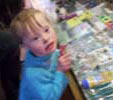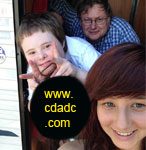

Exercises for Hypotonia
Early intervention with continuing physical and occupational therapy is essential to reduce the effects of hypotonia to the greatest degree possible, no matter when onset occured.
Effective therapy must address both the physical and verbal problems that hypotonia can cause.
Because the exercises are wildly different, we cover each category individually.
However, all therapy exercises for hypotonia share a similar theme. The common thread is trying to stimulate the motor nerve control as much as possible and to help the hypotonic develop or adjust for their differing muscle tone.
Hypotonia is a pervasive symptom of multiple disorders, and it affects everything from large physical movements to the tiny, precise muscle control necessary for speech.
ALWAYS check with an appropriate health care professional before implementing any of these suggestions, to make sure these hypotonia exercises are going to be correct for your baby/child, as well as to clarify and make sure you understand how to implement them safely.
Gross Motor Control Exercises
The first category that must be addressed is large physical movements, also known as gross motor control.
Without this, of course, the person with hypotonia can’t move through the world he or she lives in, so it’s one of the three cornerstones of therapy.
We’ve divided the most common hypotonia home intervention treatments into newborn versus older categories, as age creates the biggest difference in how to help those with hypotonia.
There are a variety of exercises to help a newborn with hypotonia, and intervention at this age may allow the baby to lead a relatively normal life. Fortunately, many of these are also applicable to people with hypotonia of any age.
For a newborn with hypotonia, you can:
1) Use firm pressure massage all over to stimulate the development of deep skeletal musculature.
2) Give the newborn lots of tummy time to stimulate movement.
3) Place baby on a towel or blanket on the floor and pull up the sides gently in order to stimulate the child into catching him or herself. Of course, be careful and keep it fun.
When baby is four or five months old, you can also use the towel or blanket as a sling to pull the child into a sitting position until they learn to do it on their own.
Most babies signal their readiness to crawl with swimming motions when they’re about nine months old. When you see these signs, you can use the towel as a sling to help your baby learn to make the crawling motions.
Always keep these sessions short and fun for both you and baby.
4) Use joint compression tights on the baby.
5) Place a small beanbag on a hand or foot and help the baby to raise that limb.
6) Bounce the baby on the floor or a large rubber ball while supported in a sitting position.
Remember to always firmly support the child by holding on to the torso, not the arms.
You can also shift baby’s weight from one buttock to the other while supporting, as this will teach your baby how to correct for imbalance.
Remember to always be safe.
7) Play games like row-your-boat, where you pull baby up and let her down in a rowing motion. Again, be careful and don’t go too fast.
8) Babies will usually indicate readiness to crawl at about nine months of age with swimming motions.
For older children and adults with hypotonia:
1) Use a backpack with books or toys in it for weight training.
2) Use small beanbags for weights and movement training on their own.
3) Help the person with hyponia to do occasional rounds of heel walking, where all of their weight is balanced on their heel and their toes stick in the air.
Exercises for those with hypotonia to develop fine motor skills
Small muscle movements are important too, of course.
Tiny, repetitive motions are what allows us to write, pick up small things, drive a car and work a computer among a multitude of other actions most of us take for granted.
To stimulate fine motor control, the following exercises come in handy for all ages.
1) Hold bright or desirable small objects out, encourage reaching for it and praise any attempt or success to do so.
2) Place toys or objects at the midline of the body and encourage drawing the limbs in to pick these objects up successfully.
3) Rub the hands and feet together, first left hand to left foot, then right hand to right food, then across the body.
4) Play patty cake and patty foot to bring hands and feet into the center of the body.
5) Use deep pressure massage on the hands and feet, focusing on the pad of the big toe and each of the fingertips.
6) Lightly brush from the heel to the toe on each foot and from the base up to the fingertips on each hand with light massage strokes or a soft, 1 inch paintbrush.
7) Draw feet up to child’s mouth, circling the mouth with each big toe. Repeat with hands and fingertips in order to increase awareness of extremities and oral motor control.
Occupational Therapy exercises for those with hypotonia
Occupational therapy will be customized to each hypotonia patient, whether newborn, toddler or adult.
Oral motor control in particular is highly technical and each case should be individually evaluated by a qualified therapist.
Any underdeveloped muscle area must be prepared for therapy through a variety of strategies including pressure massage, thermal stimulation with ice or heat, tapping and vibration. That’s just the beginning of the therapy program.
All that being said, however, there are a variety of occupational assists you can do at home. Most of these are geared towards newborns and small children, but if any seem to be a good idea for an older hypotonic, feel free to use them.
1) The first step, of course, is to give a newborn lots of smiles, hugs and cuddles. This both increases emotional bonding and stimulates baby’s senses.
2) Expose the baby to as many different pleasant stimuli as you can think of.
This includes mobiles, wind chimes, patterned cloth for crib sheets and bumpers, and musical or noise toys in bright, primary colors.
Primary colors are bright red, blue and yellow. Babies see high-contrast things the best, and love these colors.
An effective tactic that some parents have used is to cut out suitable pictures from magazines and placing on baby’s walls, which allows the frequent change-out of pictures needed to give stimulation without breaking the bank.
3) Talk to the baby often.
Tell your child what you’re doing, especially when bathing, grooming, dressing or changing her. Verbally repeat each step in the process often.
Play mimic games with your baby, repeating the sounds he will naturally make.
Encourage your baby to make sounds by making faces, singing, and talking nonsense syllables.
4) Place child-safe mirrors on crib walls or down near the floor where your baby can see himself often. This helps increase your child’s self-image and self-reflection.
5) Make a safe place for your child in every room of your house, and bring baby along as you go about your normal routine. The frequent changes in environment and constant contact with you will help stimulate your child’s mind and awareness.
6) Create tape recordings of your child’s own sounds, the sounds of your family, and appropriate music.
Play these tapes often, and dance your child around rhythmically in your arms during music or sounds.
Again, this helps your child to become aware of her own body.
7) Put toys at the midline of your child’s body to encourage her to reach inwards for them.
8) Resist any thrust of your baby’s legs while you’re holding him, and hold him often in a standing position while supporting him well in the torso.
Remember to never hang on to your baby’s arms, as this can cause damage to a child’s shoulder joints with hypotonia.
Hypotonia Exercises in Conclusion
Hopefully you’ll find ways to integrate these exercises in your daily routine. Form the habit of doing them in the course of daily living, and follow any suggestion by your physical and occupational therapist.
Remember, the best stimulus for anyone who suffers from hypotonia is lots of patience, understanding, education and, most important, love.
Research and main write by Loni L. Ice, quality control, editing and additional writing by D. S. Urquhart.

Leave a Reply
You must be logged in to post a comment.